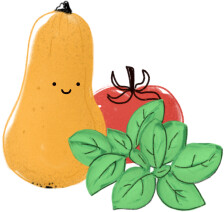Ginger

Ginger
Zingiber officinale
Plant family
Ingwergewächse (Zingiberaceae)
Season Overview
Propagating
Planting
Harvest
J
F
M
A
M
J
J
A
S
O
N
D
Details
Light requirement
Sunny
Water requirement
Wet
Soil
Medium (loamy)
Nutrient requirement
High
Plant distance
20 cm
Row spacing
30 cm
Seeding depth
5 cm
Instructions
Description
Ginger is used as a spice and medicinal plant. The part of ginger that we use is called the rhizome. Ginger belongs to the ginger family (Zingiberaceae). Its origin is believed to be in the Pacific Islands. There are different pungencies and flavors depending on the variety and where the ginger is grown. Ginger gets its pungency from its essential oils. Ginger can be used raw, cooked or as a powder. The ginger plant can grow up to 1 m tall and produces bamboo-like leaves and decorative purple flowers. Ginger also forms fleshy, capsule-shaped berries. It likes to be grown in a greenhouse or pot, as this is the best way to overwinter it. The temperature should not fall below 12 ° C.
Origin:
Pacific Islands
Growing tips
Start early, ginger has 8-10 months of cultivation. Place the ginger rhizome (about 3-5 cm long piece) flat in the soil and cover lightly with soil. Keep moist, but not wet, as ginger does not tolerate waterlogging, and keep humidity high by covering the tray/pot with foil. Expanded clay as a drainage aid can be useful. The place should have at least 20°C for germination and be semi-shaded, as direct sun is not tolerable for germination. Water with lime-free water. After germination (about 8 weeks) place in a sunnier place and remove the foil. Ginger does not tolerate frost, but should be overwintered at below 10°C. In this case also stop watering. As soon as the leaves turn yellow the ginger is ripe for harvesting. Ginger can be stored well and can also be dried. Pests include fungus gnats. Against them, cover the soil with sand. (Exotic characteristics and highly effective ingredients make ginger a loner in the bed. Because of the space-consuming growth of its rhizomes and stolons, this exotic super-plant is not suitable for mixed cultivation. Similar to lovage, wormwood, turmeric or hyssop, ginger makes itself unpopular as a plant neighbor in the garden and greenhouse. (From gardenjournal.net).
Companion Plants
No companion plants
Antagonistic Plants
No antagonistic plants
Diseases
Root Rot
Pests
Voles